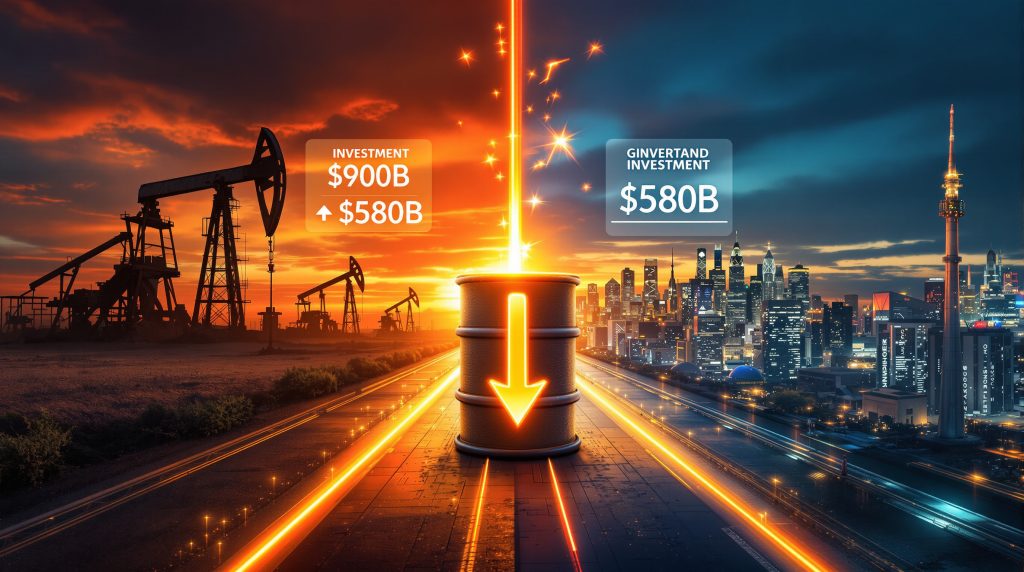How Serious is the Underinvestment Problem in Oil and Gas?
The global oil and gas sector faces a critical challenge that could reshape energy markets for decades to come. After reaching a peak of nearly $900 billion in 2014, annual upstream investment has contracted significantly, hovering around $580-600 billion in recent years. This 35% decline represents more than just budget cuts – it signals a fundamental shift in how energy companies approach capital allocation and long-term planning.
According to the International Energy Agency, global upstream oil and gas investment reached $586 billion in 2023, representing a recovery from pandemic lows but still well below the 2014 peak of approximately $780 billion when adjusted for inflation.
Industry analysts are increasingly concerned that this persistent underinvestment in oil and gas sector could create severe supply constraints, potentially leading to price volatility and energy security challenges. The structural shift toward maintaining production rather than growth-oriented investment represents a fundamental change in industry strategy that could have long-term supply implications.
Investment levels would need to reach approximately $640 billion annually by 2030 under the IEA's Stated Policies Scenario to meet projected demand growth, highlighting the significant gap between current spending and future requirements.
Why Has Investment in Oil and Gas Declined?
The Perfect Storm of Market Pressures
Multiple factors have converged to create today's investment landscape:
-
Shareholder Demands: After years of disappointing returns, investors have pressured companies to prioritize dividends and share buybacks over growth-oriented capital expenditure.
-
Price Volatility: Extreme oil price movements and swings, including the 2020 crash that briefly sent oil futures negative, have made long-cycle projects appear increasingly risky.
-
Energy Transition Concerns: Uncertainty about long-term demand amid climate policies and renewable energy growth has shortened investment horizons.
-
ESG Pressures: Financial institutions face growing pressure to reduce fossil fuel exposure in their portfolios.
-
Regulatory Uncertainty: Shifting policies around carbon taxes, methane regulations, and drilling permits complicate investment decisions.
The result is an industry that has become extraordinarily disciplined with capital, focusing on short-cycle projects with rapid payback periods rather than the major developments that historically sustained production growth.
Global oil and gas companies returned $544 billion to shareholders through dividends and buybacks in 2022-2023, compared to $467 billion invested in upstream development during the same period, demonstrating the prioritization of shareholder returns over growth capital.
The Pandemic's Lasting Impact
The COVID-19 pandemic accelerated these trends dramatically. When demand collapsed in 2020, companies slashed spending by approximately 30% compared to pre-pandemic plans, representing the sharpest annual decline on record. While investment has partially recovered, it remains well below pre-pandemic trajectories and far from the 2014 peak.
Financial analysts note that after the 2014-2020 period, during which oil majors generated returns on capital employed (ROCE) averaging only 4-6%—well below their cost of capital—investor patience evaporated. This led to demands for immediate returns rather than promises of future production growth.
This pullback wasn't merely a temporary response to market conditions—it represented a structural shift in industry strategy toward capital discipline and shareholder returns.
The Declining Productivity Challenge
Depletion: The Relentless Reality
Oil and gas fields naturally decline over time. Without continuous investment in new wells and enhanced recovery techniques, production inevitably falls:
- Conventional Fields: Typically decline at 3-7% annually
- Unconventional (Shale) Fields: Can decline at 15-40% in the first year alone
- Global Average: Approximately 6-8% annual decline rate across all production
This means the industry must invest simply to maintain current production levels, let alone grow to meet increasing demand.
U.S. shale well productivity (initial production rates) in the Permian Basin declined approximately 15% between 2019 and 2023 as operators depleted tier-1 drilling locations, demonstrating the real-world impact of high-grading followed by depletion of premium assets.
Petroleum engineers emphasize that decline rates are a fundamental physical reality of hydrocarbon extraction. As reservoir pressure decreases and water breakthrough occurs, production naturally falls. For unconventional resources like shale, the high initial decline rates are due to the limited drainage area of horizontal wells compared to conventional reservoirs.
The Shale Dilemma
U.S. shale production, which drove much of the past decade's supply growth, presents a particular challenge. These wells:
- Decline rapidly, requiring constant drilling to maintain production
- Have seen productivity per foot drilled decrease in many areas as the best locations are developed first
- Require more drilling activity to generate the same production increases as in previous years
Without substantial ongoing investment, U.S. production could theoretically decline by 75% between 2025 and 2035, creating an enormous gap in global supply.
The Permian Basin in Texas provides a perfect case study. Maintaining its current production of approximately 6.1 million barrels per day requires drilling approximately 5,000 new wells annually at a cost of $30-35 billion. Without this investment, production would decline approximately 75% over 10 years.
Quantifying the Investment Gap
How Much Investment is Needed?
According to industry analyses, sustainable production to meet projected demand would require:
- Approximately $640-650 billion in annual upstream investment by 2030
- Current investment trajectories suggest only $570-580 billion by 2025
- This creates a potential funding gap of $60-80 billion annually
The International Energy Agency (IEA) has warned that continued underinvestment could lead to market tightness and price volatility, particularly if demand proves more resilient than some transition scenarios suggest.
Energy analysts emphasize that investment gaps are particularly concerning because of the long lead times in oil development. Projects approved today typically don't produce meaningful volumes for 4-7 years, meaning investment shortfalls in 2020-2024 will manifest as production shortfalls in 2025-2030.
The Widening Supply-Demand Imbalance
If current investment trends continue, several major forecasters project significant supply shortfalls:
| Organization | Projected Supply Gap (2030) | Assumptions |
|---|---|---|
| OPEC | Up to 23 million barrels/day | Worst-case scenario with minimal new investment |
| ExxonMobil | 70 million barrels/day | If all new investment stopped immediately |
| IEA | 5-7 million barrels/day | Based on current policies scenario |
While these represent different scenarios, they all point toward potential market tightness if investment doesn't increase substantially.
OPEC's 2023 World Oil Outlook projected that without adequate investment, spare capacity could fall below 1.5 million barrels per day by 2030, compared to a historical average of 3-4 million barrels per day, creating significant risk for market stability during supply disruptions.
Regional Vulnerabilities and Resilience
High-Decline vs. Low-Decline Regions
The impact of underinvestment varies significantly by region:
- North America: Highly vulnerable due to rapid decline rates in shale fields
- Middle East: More resilient with conventional fields that decline at only 2-3% annually
- Offshore: Mixed picture with high initial investment but potentially longer production plateaus
This disparity could shift global production increasingly toward OPEC+ nations, potentially increasing market concentration and price-setting power.
Middle East conventional fields decline at approximately 2-3% annually without active management, the lowest rates globally due to favorable reservoir characteristics including large, well-connected reservoir volumes and strong natural pressure support.
The Permian Paradox
The Permian Basin in Texas and New Mexico illustrates the investment challenge perfectly:
- Remains the most active and productive U.S. shale basin
- Has maintained production growth despite reduced drilling activity
- Shows signs of productivity plateaus in some areas
- Requires continuous high investment to offset natural decline rates
Even this powerhouse region cannot escape the fundamental need for ongoing capital deployment.
North American production (primarily shale) faces natural decline rates of 30-50% in year one for individual wells, making the region highly vulnerable to investment reductions compared to more resilient conventional production in other regions.
The Services Sector Squeeze
A Critical but Overlooked Dimension
The oilfield services sector has experienced even more severe investment constraints:
- Capital expenditure by service companies has fallen by 50-80% from peak levels
- Equipment fleets (drilling rigs, pressure pumping units) have been reduced
- Skilled workforce reductions limit capacity to rapidly scale up
- Consolidation has reduced competitive pressures
This "invisible" underinvestment could prove just as consequential as upstream spending declines, creating bottlenecks even if producer spending increases.
Oilfield services company capital expenditure declined approximately 60% from 2014 peak levels as of 2023, with much of the equipment retired permanently rather than maintained in cold storage for future use.
Rising Service Costs
The services sector contraction is already manifesting in rising costs:
- Drilling day rates have increased 15-30% in many regions
- Pressure pumping costs have risen similarly
- Skilled labor shortages have pushed wages higher
- Equipment shortages have extended project timelines
These cost pressures further complicate the investment equation for producers.
The global offshore drilling fleet declined from approximately 735 rigs in 2014 to 462 in 2023, with many units scrapped rather than cold-stacked, demonstrating the permanent capacity reduction that has occurred in this critical sector.
Industry observers note that the services sector experienced more severe financial distress than exploration and production companies during downturns. Over 200 North American oilfield services companies filed for bankruptcy between 2015 and 2020, consolidating the industry significantly.
Demand Resilience: The Other Side of the Equation
The Persistent Growth Trend
Despite transition narratives, global oil demand has shown remarkable resilience:
- Has grown at approximately 1% annually for four decades
- Recovered rapidly from pandemic disruptions
- Reached new record highs in 2023 and 2024
- Shows continued growth in emerging markets
This persistent demand growth makes the investment shortfall particularly concerning.
Global oil demand reached 102.2 million barrels per day in 2023, a new record high, exceeding pre-pandemic levels despite expanded electric vehicle adoption and efficiency gains.
Energy economists observe that oil demand has proven remarkably resilient despite decades of efficiency improvements, alternative energy adoption, and climate policies. The key driver is that oil serves diverse end-uses beyond transportation, many of which lack near-term substitutes.
Beyond Transportation Fuel
While electric vehicle adoption may eventually impact gasoline demand, oil serves many purposes beyond transportation:
- Petrochemical feedstocks for plastics and materials
- Aviation fuel (with limited near-term alternatives)
- Industrial processes
- Shipping and heavy transportation
These sectors show few signs of demand reduction and could continue driving consumption growth even as light vehicle electrification advances.
Petrochemical feedstock demand for oil is projected to grow by 3-4 million barrels per day by 2030, even as transportation fuel demand may plateau, highlighting the diversified nature of oil consumption.
Aviation fuel demand reached 7.2 million barrels per day in 2023, recovering to approximately 95% of 2019 levels, with minimal viable alternatives for long-distance air travel, demonstrating the sector's continued reliance on oil-based fuels.
What Could Trigger a Market Response?
Price Signals and Investment Cycles
Energy markets typically correct through price mechanisms:
- Higher prices eventually stimulate investment
- New supply comes online after development lag (typically 3-7 years)
- Prices moderate as supply and demand rebalance
However, several factors could disrupt this traditional cycle:
- Capital Discipline: Companies may remain reluctant to invest even at higher prices
- Financing Constraints: ESG considerations may limit available capital
- Supply Chain Bottlenecks: Service sector limitations could delay response
- Policy Uncertainty: Regulatory changes could complicate investment decisions
These factors suggest that price signals may need to be stronger and more sustained to trigger adequate investment response.
Market analysts note that typical oil market cycles see investment respond to price signals with a 2-3 year lag. However, the current cycle may be different due to capital discipline mandates, ESG concerns, and reduced service sector capacity, potentially requiring sustained higher prices ($85-100+ WTI) for 12-18 months to trigger meaningful investment response.
The Potential for Price Volatility
The combination of underinvestment and demand resilience creates conditions for increased price volatility:
- Reduced spare capacity limits ability to respond to disruptions
- Tighter inventories provide less buffer against supply shocks
- Concentration of production in fewer regions increases geopolitical risk
- Weather events and technical outages could have outsized market impacts
This volatility itself can further complicate investment decisions, potentially creating a negative feedback loop.
Global oil inventories averaged 2.85 billion barrels in 2023, representing approximately 28 days of forward consumption, near the lower end of the 5-year range, providing limited cushion against supply disruptions.
OPEC+ countries controlled approximately 51% of global crude oil production as of 2023, up from 48% in 2018, indicating increasing production concentration that could impact market dynamics and pricing power.
Is There a Middle Path?
Balancing Transition and Security
Some industry leaders advocate for a more nuanced approach:
- Continued investment in low-cost, lower-carbon oil and gas production
- Focus on reducing emissions intensity of existing operations
- Parallel investment in alternative energy technologies
- Maintaining energy security while transition progresses
This "and, not or" strategy acknowledges both climate imperatives and practical energy transition challenges and energy security requirements.
While transition to cleaner energy sources remains a priority, balancing near-term energy security with longer-term climate goals requires continued investment in efficient hydrocarbon production alongside accelerated clean energy development.
Technology as a Potential Bridge
Technological advances could help address some underinvestment concerns:
- Enhanced recovery techniques to improve existing field output
- Automation and digitalization to reduce operating costs
- Carbon capture to reduce emissions intensity
- Methane leak detection and prevention technologies
These innovations may help extend production from existing assets while reducing environmental impact.
Digital technologies, including artificial intelligence applications in reservoir management and predictive maintenance, could potentially offset some underinvestment impacts by improving recovery rates and reducing operational costs.
What Should Investors Watch?
Key Indicators of Market Direction
Several metrics can help gauge whether underinvestment concerns are materializing:
- Rig Counts and Drilling Activity: Early indicators of production trends
- Well Productivity Metrics: Signal whether efficiency gains are continuing
- Decline Rates in Major Basins: Indicate sustainability of current production
- Service Sector Capacity Utilization: Potential bottleneck for production growth
- Spare Production Capacity: Buffer against market disruptions
- Inventory Levels: Another key buffer against supply shocks
Monitoring these indicators can provide early warning of potential supply constraints.
The combination of declining well productivity per foot drilled and reduced drilling activity presents a concerning signal for future U.S. production potential, even as headline production numbers remain strong.
Company Strategies as Signals
Energy company capital allocation decisions also provide important insights:
- Shifts from share buybacks toward growth capital expenditure
- Increased exploration budgets
- Acquisitions focused on undeveloped resources rather than current production
- Long-cycle project approvals
These strategic moves could signal changing industry perspectives on the investment-return equation.
The services sector offers particularly compelling investment opportunities due to extreme valuation discounts, with some companies trading at 20% of replacement cost while generating 20% free cash flow yields – a historically unusual combination that suggests significant potential upside as capital expenditure eventually increases.
Conclusion: The Balancing Act Ahead
The oil and gas industry faces a complex balancing act between meeting near-term energy needs and positioning for long-term transitions. Current underinvestment trends create significant risk of supply constraints and oil price crash factors and price volatility if demand proves more resilient than some projections suggest.
While efficiency gains and technological advances have partially offset reduced investment, the industry's natural decline rates create a relentless need for capital deployment simply to maintain production. The services sector contraction adds another layer of complexity that could limit how quickly supply can respond to market signals.
For investors, policymakers, and industry participants, navigating this uncertain landscape requires careful attention to both supply-side constraints and demand evolution. The coming years may well reveal whether today's investment caution represents prudent discipline or a collective underestimation of future energy needs.
The parallels between the current oil market setup and previous commodity bull markets are striking. As seen with gold safe haven insights, periods of extended underinvestment eventually lead to supply constraints and price recoveries that often exceed mainstream expectations. The historical relationship between oil and gold prices suggests potential for significant oil price appreciation following the recent precious metals rally.
Investment Perspective: The current market sentiment toward oil appears heavily skewed to the bearish side despite persistent 1% annual demand growth over four decades and accelerating underinvestment in oil and gas sector. This contrarian setup, combined with Alaska drilling policy changes and underinvestment concerns, creates a potentially compelling opportunity for patient investors.
Ready to Spot the Next Major Mineral Discovery?
Ensure you're the first to know about significant ASX mineral discoveries by exploring Discovery Alert's proprietary Discovery IQ model, which transforms complex mineral data into actionable insights for investors. Understand why major mineral discoveries can lead to exceptional returns by visiting Discovery Alert's dedicated discoveries page.




